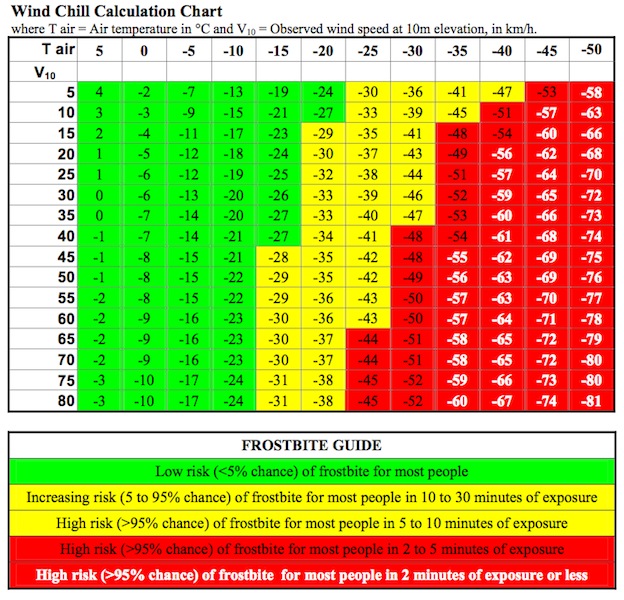The Chicagoist Winter Bike Guide (Part 2: Dress for Success)
By Kim Bellware in News on Dec 21, 2011 10:00PM

If you caught Part 1 of our Winter Bike Guide, you know how to deck your two wheels out for winter weather. In Part 2, we'll show you how to swaddle yourselves for ultimate warmth, comfort and safety.
The Basics of Dressing for Winter Biking
The good news is, you don't need to wear as much clothing as you might think. Whether you're heading out for a long ride or are doing a 20-30 minute commute to work, dress warmer than the actual outside temperatures otherwise you run the risk of overheating or heat exhaustion, and it could be more than the irony that kills you. Find your own comfort level, but we tend to dress a good 20 degrees below whatever the actual temperature is like outside.
Cover exposed skin-including ears, neck and hands-in above freezing weather for comfort and in below freezing weather as a necessary safety precaution. Particularly against your legs and torso, a base layer of silk or some synthetic wicking material will be your best friend and keep you from feeling clammy, gross and potentially pneumonia-ridden. If your ears are cold but you don't want to rock a full hat, 180s headwarmers can keep your ears toasty.
Phil Marmet, Manager of Copenhagen Cyclery, breaks it down a bit further in the video below:
Above Freezing
Until the mercury dips below freezing, you can get away with pretty minimal cover, ranging from a wool sweater to a performance-weight jacket. TyK alum and winter biker Rebecca Resman suggests leg and arm warmers for coverage with less bulk. 
When biking in winter, you'll want a hat, scarf, goggles and something to cover your face (image credit: Mickey Brick)
And though it might not be freezing, don't neglect your to protect your eyes. We'll spare you the details, but we overheard this horror scenario: winter air is dry, and the average cyclist riding to work will bike about 10-12 mph. The dry, cold air combined with the wind speed means if you have nothing over your eyes, your eyeballs can dry out enough to where your eyelids stick and rip your corneas.
Below, Marmet discusses ear, eye and nose protection.
Below Freezing
Inevitably, it will get cold enough for snot to freeze to your face and you'll be tempted to grab your CTA pass unless you're properly equipped. When the weather is at or below freezing, your risk of frostbite goes up. Keeping in mind the average 10-12 mph speed of cycling (and remember, you might be going a little slower in colder weather due to ice or snow), this frostbite guide (written for the Department of Defense) will give you an idea of how long you can be outside depending on the temperature before you start to run the risk of frostbite (note that all these estimates are for dry skin only; your risk of frostbite goes up quickly as soon as your skin is wet).

Frostbite guide via the Defense Technical Information Center (DTIC)
Becky Welbes, Founder of the women's cycling organization Pretty-Fast suggests thin under layers to keep from freezing.
"For legs, thick warm leggings or running/ cycling tights slip over regular tights," says Welbes. "You can sneak into the bathroom and take this layer off quickly and then step out like Wonderwoman, ready to look nice for a party or work. They also go good under your jeans if you prefer."
With thin, wicking layers underneath, you can easily navigate below-freezing rides without feeling like the Stay Puft Marshmallow Man. And while we're on the subject of puffs, it's rare that you will need a puffy down coat. If it's that cold, it's probably blizzard-like conditions and well...those make it unsafe for anyone
to be outside.
Wind- and Waterproofing
When it's raining or snowing wet slop or blowing gale-force winds, the easiest way to stay warm and dry is to don wind- and waterproof gear. A waterproof shell might be too much on dry days because it will trap too much heat without allowing your skin to breathe; otherwise, shells are good, lightweight ways to weatherproof your regular winter clothes. If you don't own any or just get caught in a storm without your preferred gear, plastic bags are a cheap way to make it to your destination dry. You can rubber band grocery or sandwich bags around your shoes to keep the moisture out, but we prefer to put those on over our socks and under the shoe or boot to lessen the chances of the bag getting caught in the chain. For the rest of your body, punch a hole in a garbage bag, pretend it's a poncho and be on your way.
We asked Marmet for a few more thoughts on gear to shield you from the wind and rain.
A Few of Our Favorites
We gathered a few pieces that we rely on each winter and asked a few other winter bikers to share what gear they can't bike through the season without.
Resman is a fan of Giro's helmets from the snowboard line. While the company makes helmets for regular biking, the snowboard versions come with built-in ear warmers.
Chicagoist Jefe and winter cyclist, Chuck Sudo, likes the Pear Izumi Softshell Lobster Glove for his hands, and for his eyes, ski goggles. ("I buy mine at Viking Ski Shop on Fullerton.")
Touring cyclist and TyK illustrator Jana Kinsman hipped us to the marvelous Buff headwear that can be worn as a scarf, a gaiter, a hat, a balaclava-or a dozen other ways (the merino wool version is easier to breathe through if you decide to wear it around your mouth).
Both Marmet and Welbes like rainproof pants of any kind (REI has one of the larger stocks in the city). Below the knee, everyone seems to like Smartwool--they're the only socks we're actually happy to receive at Christmas.
Safety Notes
Winter bike gear isn't by definition super cute, so you'll have to set aside your Bird of Paradise vanity in order to enjoy safe winter biking. Some may dog them for looking dorky, but reflective vests can help cars and other traffic spot you easier. Black, blue, brown and gray will always be tough to see at night, but red can often look black at dusk, too, so don't think you'll be safer just because you're sporting a bright color. School bus yellow is the most visible, but nothing beats flashing lights or reflectors.
If you can't commit to an entire vest, shops like Uptown Bikes and others sell reflective tape in sliver and black that you can iron and hand-tack on to whatever article of clothing you like.
Rocking wet gear for a ride won't do much for you in the warmth department and can even speed up frostbite. Jam old newspaper into pant legs and shoes, and put gloves and hats over bottles to help them dry (most reflective and performance materials can't go in the dryer).
If you want to know how to wrap your aprés biking clothes, Lifehacker has a nice little post about how to roll your items up efficiently and wrinkle-free.
Mr. Marmet sends you off with a few tips on dressing yourself for winter biking on a budget.
Did we miss anything? Do you have a favorite tip you want to add? Share it all in the comments. Stay warm, stay safe, and have fun on the road.
Special thanks to Uptown Bikes, Copenhagen Cyclery, Prett-Fast and TyK